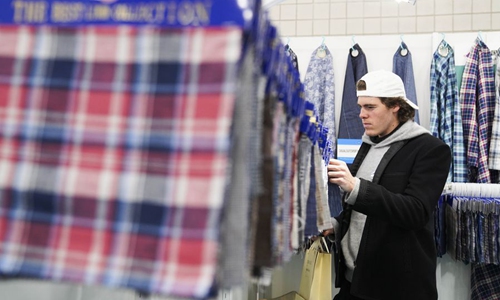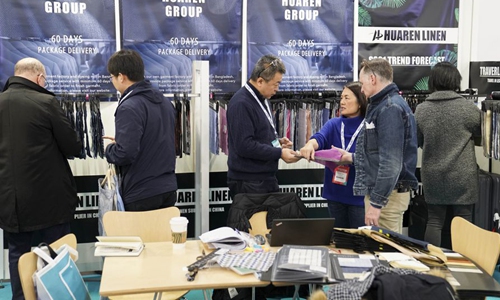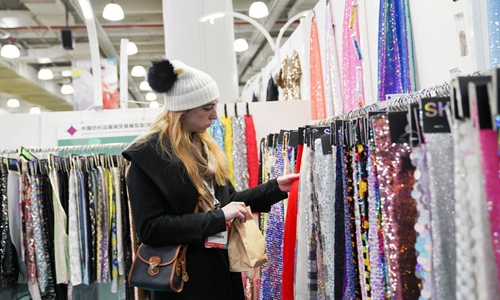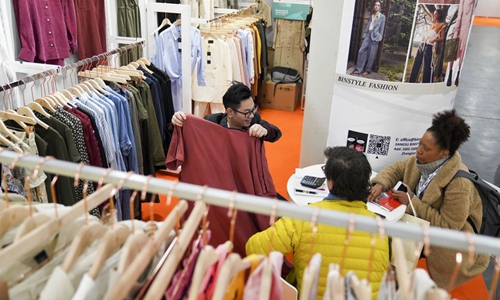HOME >> SOURCE
Chinese textile companies seeking US market expansion
Source:Xinhua Published: 2020/1/24 17:45:31

A buyer looks at fabric samples during the 21th China Textile and Apparel Trade Show (New York) in New York, the United States, Jan. 21, 2020. (Xinhua/Wang Ying)
Chinese textile companies have been actively exploring and expanding into the US market through more innovation, upgraded services and bigger global footprints, according to industry insiders.
"We've been investing 7 percent of our annual revenue in our research and development efforts since 2015," said Jiang Nan, executive director and general manager of RomRol Outdoor, a Jiangsu Province-based company committed to developing functional fabric and clothing to serve mostly outdoor brands and brands with fashion outdoor collections.
At the just-concluded China Textile and Apparel Trade Show in New York City, RomRol Outdoor presented attendees, namely retailers, designers and brands, a catwalk show highlighting its various cutting-edge technologies. Its light-absorbing fabric and temperature sensor fabric proved to be most eye-catching.
RomRol Outdoor is only one of the many Chinese companies that emphasize technology and innovation in order to be more competitive on the global market.

Buyers slecet fabric samples during the 21th China Textile and Apparel Trade Show (New York) in New York, the United States, Jan. 21, 2020. (Xinhua/Wang Ying)
"We are still a decade behind our counterparts in countries like Germany and Japan, but that also means we have huge potential for growth," said Jiang.
He explained that Chinese companies used to only eye on the already large domestic market, but as the domestic market becomes saturated and communication with international partners becomes ever closer, they are now more eager to compete on the global stage and expand their international market share.
The show was held in parallel with the Home Textiles Sourcing, Apparel Sourcing USA, and the Texworld USA expos, all at the Javits Center earlier this week and bringing together more than 300 exhibitors from 17 countries and regions around the world.
More than half of the exhibitors came from China, and they produce cotton, functional fabrics, knits, faux fur, embroidery, lace, and more.
Headquartered in China's southeastern Xiamen city, the brand Grit & Zest established a branch in the United States in 2012. Specializing in swim, active, athleisure and casual wears, the company is one of the early ones to have presence in the United States in order to communicate with customers more smoothly and respond to their requests more quickly.
Mary Chua, president of Grit & Zest's US company, said that with comparative advantages of labor resources and competitive prices, it used to be easy to sell products to the US market.

Buyers slecet fabric samples during the 21th China Textile and Apparel Trade Show (New York) in New York, the United States, Jan. 21, 2020. (Xinhua/Wang Ying)
"But not anymore," said Chua, adding that starting from 2015, the company has been offering more value-added products when doing business with its customers.
The brand offers design help and expert supervision from sample cycle to production. Its services include collection development, multi-language tech-packs, textile design, print design, graphic design, fabric and trim sourcing, testing, hardware design, label or packaging design, and garment fitting checks.
Chua said the company's competitive advantage lies exactly in its ability to offer the whole package. In addition, if a startup only has a design concept for its clothing line but does not know where to start, Grit & Zest can also help.
"We have to adapt and transform, following the trend closely," said Chua.
An increasing number of Chinese companies are also expanding their global footprints to show their US customers that they are flexible and have enough capacity.
Xu Yan, assistant general manager of Jiangsu Guotai Huasheng Industrial Co., Ltd., said she has established quite a few partnerships with manufacturers in southeast Asian countries such as Vietnam and Indonesia, and already has three plants of their own in Myanmar.
"It all started in the past two to three years when we realized we had to look for alternative manufacturing bases other than China," said Xu.

A buyer looks at product samples during the 21th China Textile and Apparel Trade Show (New York) in New York, the United States, Jan. 21, 2020. (Xinhua/Wang Ying)
Chinese companies turn to southeast Asian countries or even African countries to meet the needs of their customers, and to move some of their production capacity outside of China so that mid-to-high-end products can still be manufactured in China, industry insiders said.
They added that now Chinese companies are truly competing on the global stage as countries like Vietnam have also entered the arena, while those that are already there for a long time such as Japan are still striving to move forward.
"That's a challenge we have to face," Xu said.
Posted in: ECONOMY